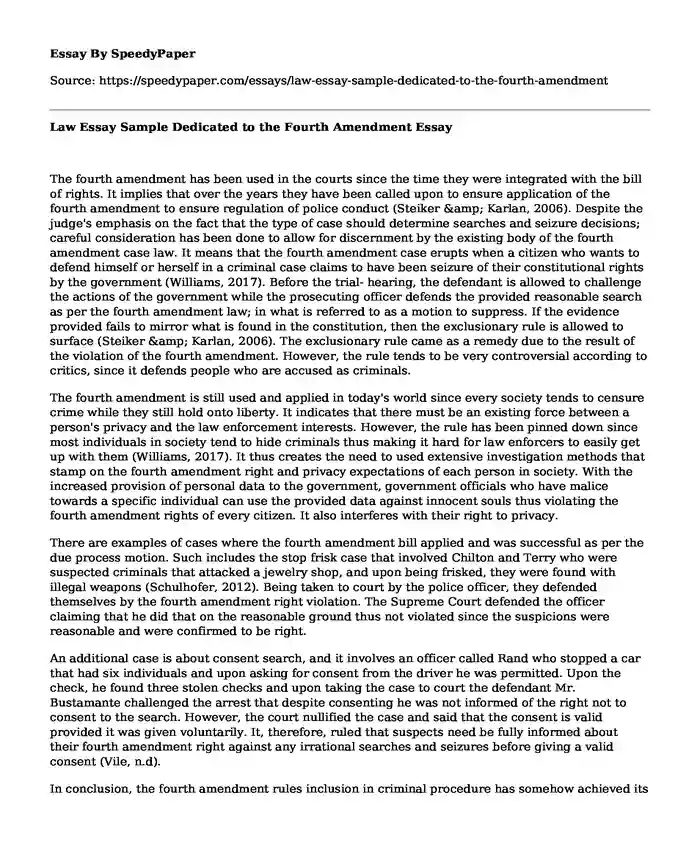
| Type of paper: | Essay |
| Categories: | Criminal law Constitution |
| Pages: | 3 |
| Wordcount: | 714 words |
The fourth amendment has been used in the courts since the time they were integrated with the bill of rights. It implies that over the years they have been called upon to ensure application of the fourth amendment to ensure regulation of police conduct (Steiker & Karlan, 2006). Despite the judge's emphasis on the fact that the type of case should determine searches and seizure decisions; careful consideration has been done to allow for discernment by the existing body of the fourth amendment case law. It means that the fourth amendment case erupts when a citizen who wants to defend himself or herself in a criminal case claims to have been seizure of their constitutional rights by the government (Williams, 2017). Before the trial- hearing, the defendant is allowed to challenge the actions of the government while the prosecuting officer defends the provided reasonable search as per the fourth amendment law; in what is referred to as a motion to suppress. If the evidence provided fails to mirror what is found in the constitution, then the exclusionary rule is allowed to surface (Steiker & Karlan, 2006). The exclusionary rule came as a remedy due to the result of the violation of the fourth amendment. However, the rule tends to be very controversial according to critics, since it defends people who are accused as criminals.
The fourth amendment is still used and applied in today's world since every society tends to censure crime while they still hold onto liberty. It indicates that there must be an existing force between a person's privacy and the law enforcement interests. However, the rule has been pinned down since most individuals in society tend to hide criminals thus making it hard for law enforcers to easily get up with them (Williams, 2017). It thus creates the need to used extensive investigation methods that stamp on the fourth amendment right and privacy expectations of each person in society. With the increased provision of personal data to the government, government officials who have malice towards a specific individual can use the provided data against innocent souls thus violating the fourth amendment rights of every citizen. It also interferes with their right to privacy.
There are examples of cases where the fourth amendment bill applied and was successful as per the due process motion. Such includes the stop frisk case that involved Chilton and Terry who were suspected criminals that attacked a jewelry shop, and upon being frisked, they were found with illegal weapons (Schulhofer, 2012). Being taken to court by the police officer, they defended themselves by the fourth amendment right violation. The Supreme Court defended the officer claiming that he did that on the reasonable ground thus not violated since the suspicions were reasonable and were confirmed to be right.
An additional case is about consent search, and it involves an officer called Rand who stopped a car that had six individuals and upon asking for consent from the driver he was permitted. Upon the check, he found three stolen checks and upon taking the case to court the defendant Mr. Bustamante challenged the arrest that despite consenting he was not informed of the right not to consent to the search. However, the court nullified the case and said that the consent is valid provided it was given voluntarily. It, therefore, ruled that suspects need be fully informed about their fourth amendment right against any irrational searches and seizures before giving a valid consent (Vile, n.d).
In conclusion, the fourth amendment rules inclusion in criminal procedure has somehow achieved its purpose but fails to protect innocent citizens from private owners, who might interfere with their right to privacy.
References
Bannon, M. E. (2003). A quick reference guide to contemporary criminal procedure for law enforcement officers: One hundred notable United States Supreme Court decisions and their effect on modern policing in America. Springfield, IL: C.C. Thomas.
Schulhofer, S. J. (2012). More essential than ever: The Fourth Amendment in the twenty-first century. New York: Oxford University Press.
Steiker, C. S., & Karlan, P. S. (2006). Criminal procedure stories. New York, NY: Foundation Press/Thomson/West.
Vile, J. (n.d.). Schneckloth v. Bustamonte (1973). Encyclopedia of the Fourth Amendment. doi:10.4135/9781452234243.n677
Williams, L. V. (2017). Terry v. Ohio. The Encyclopedia of Juvenile Delinquency and Justice, 1-4. doi:10.1002/9781118524275.ejdj0106
Cite this page
Law Essay Sample Dedicated to the Fourth Amendment. (2022, Mar 11). Retrieved from https://speedypaper.com/essays/law-essay-sample-dedicated-to-the-fourth-amendment
Request Removal
If you are the original author of this essay and no longer wish to have it published on the SpeedyPaper website, please click below to request its removal:
- Free Essay Sample on Interdisciplinary Collaboration in Shared Governance
- Free Essay on Leadership and Cognitive Bias
- Employee Privacy Rights and Packet Sniffers. Free Essay Sample.
- Finance Essay Sample: Continuous Budgeting
- Essay Sample: GES Core Competencies and Capabilities
- Essay Sample on Healthcare Data Shortages
- Special Topics in Criminal Justice. Free Essay
Popular categories




